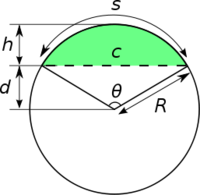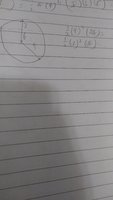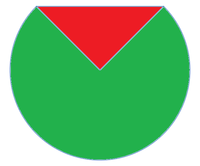Some radian cutting circles in parts question, please help!
- Thread starter Leah5467
- Start date
HallsofIvy
Elite Member
- Joined
- Jan 27, 2012
- Messages
- 7,763
Set up a coordinate system with origin at the post to which the sheep is tetherd. The sheep is on a tether of length 9 meters so, if there were no fence could graze on the interior of the circle $x^2+ y^2= 81$. Take the fence to be at x= 6. The area on which the sheep can graze is \(\displaystyle \int_{-9}^6 2\sqrt{81- x^2}dx$\)
Last edited:
Dr.Peterson
Elite Member
- Joined
- Nov 12, 2017
- Messages
- 16,826
First, you need to make a drawing showing what the region you are asked for looks like. The sheep can't go past the fence.
I would then use the Pythagorean Theorem to find the two farthest points on the fence that the sheep can reach, and trigonometry to find the angle of arc through which it can move away from the fence. Then you can divide the area covered in two parts, a triangle and a sector of a circle.
Do you notice that we have suggested two very different approaches, one assuming you know calculus, and the other not? This is why we ask you for context, so we can know what tools you are able to use. The more you tell us about your knowledge and work, the more efficiently we can help.
Please read the submission guidelines, which (if you read them) explained this.
I would then use the Pythagorean Theorem to find the two farthest points on the fence that the sheep can reach, and trigonometry to find the angle of arc through which it can move away from the fence. Then you can divide the area covered in two parts, a triangle and a sector of a circle.
Do you notice that we have suggested two very different approaches, one assuming you know calculus, and the other not? This is why we ask you for context, so we can know what tools you are able to use. The more you tell us about your knowledge and work, the more efficiently we can help.
Please read the submission guidelines, which (if you read them) explained this.
pka
Elite Member
- Joined
- Jan 29, 2005
- Messages
- 11,989
Frankly I am assuming that the picture is misleading in that the fence extends in both directions.View attachment 11416
my failed solution: Answer is 227 m square.
Have a look at this reference. You want the area of the circle minus the area of the Circular_segment(the green).
We are given that R=9,d=6, as a result h=3.
We θ the central angle. I suggest that Θ=2arccos(96).
Last edited:
Why do you say that the problem misdescribes itself?Frankly I am assuming that the picture is misleading in that the fence extends in both directions.
pka
Elite Member
- Joined
- Jan 29, 2005
- Messages
- 11,989
I think that the the fence extend beyond what it appears to do so in the diagram.Why do you say that the problem misdescribes itself?
Actually I was thinking of a long ago argument I had. The cow was tethered to the middle of a side of a barn. The tether was much longer than the width of the barn meaning the cow could graze in two quarter circles at each end of that side of the barn.
Last edited:
Dr.Peterson
Elite Member
- Joined
- Nov 12, 2017
- Messages
- 16,826
I think the problem is reasonably clear. The fence is "long", implying long enough that we don't need to know its length. The drawing shows arrows on the ends, which conventionally mean that it extends beyond what is show, potentially infinitely. And even if we take it as being drawn to scale, 9 meters will not reach past those arrows.
All we lack now is for Leah to report back on whether what we've said was helpful, including a picture of her current understanding of the problem, and whatever work she has attempted.
All we lack now is for Leah to report back on whether what we've said was helpful, including a picture of her current understanding of the problem, and whatever work she has attempted.
Dr.Peterson
Elite Member
- Joined
- Nov 12, 2017
- Messages
- 16,826
... or, if you don't know the area of a segment of a circle, the area of an isosceles triangle plus the area of a sector of a circle, following my suggestion.
pka
Elite Member
- Joined
- Jan 29, 2005
- Messages
- 11,989
I wonder if Prof Peterson could tell us about his solution? What did I miss?yeah i think i got it. From using Dr.Peterson's solution. But thank you for the other solutions. I just don't understand calculus yet.
Dr.Peterson
Elite Member
- Joined
- Nov 12, 2017
- Messages
- 16,826
Great! If you'd like, you can share your solution here for the benefit of others. MarkFL's picture does give the idea that I (and I believe, you) used. The same picture (or one like it) can be used to find a general formula for a circular segment, as was mentioned; calculus is an alternate method, and not essential. (It provides one way to do many things, rather than having to learn many separate formulas.)yeah i think i got it. From using Dr.Peterson's solution. But thank you for the other solutions. I just don't understand calculus yet.
pka
Elite Member
- Joined
- Jan 29, 2005
- Messages
- 11,989
But that has absolutely nothing to do with the solution.I believe he suggested decomposing the area into an isosceles triangle and a circular sector:
View attachment 11427
This does: This image does

The answer to the question is the area of the circle minus the area of the circular segment(green area) subtracted from the area of the circle.
- Joined
- Nov 24, 2012
- Messages
- 3,021
But that has absolutely nothing to do with the solution.
This does: This image doesView attachment 11429
The answer to the question is the area of the circle minus the area of the circular segment(green area) subtracted from the area of the circle.
Nothing to do with the solution? The answer can also be found from equivalently finding the area of the triangle and the sector and adding them.
Otis
Elite Member
- Joined
- Apr 22, 2015
- Messages
- 4,592
I think the double-arrowed line is misleading, as that's a common diagram-convention for marking a specific object.I think the problem is reasonably clear …
Or, did you think it represented the Real number line?
Dr.Peterson
Elite Member
- Joined
- Nov 12, 2017
- Messages
- 16,826
What I meant by "reasonably clear" is that, though it could have been stated better, no other interpretation that makes sense would lead to a different answer. (Unless you think sheep can hop over the fence, which is a different issue.)
Yes, the arrows are meant to remind you of a line, which extends forever; in a real-world context, that means it extends far enough that you don't need to pay attention to the ends. (Physics teachers don't mind talking about infinite wires.) If you believed it was meant literally, would that change your answer to the problem?
If I had written the problem, I might have made the fence 100 meters long, but that might make some students worry that they had to use that number somewhere. I imagine the author was doing his best to keep students from worrying about the rope wrapping around the ends (which would make it a much more interesting problem, but not what was intended).
Yes, the arrows are meant to remind you of a line, which extends forever; in a real-world context, that means it extends far enough that you don't need to pay attention to the ends. (Physics teachers don't mind talking about infinite wires.) If you believed it was meant literally, would that change your answer to the problem?
If I had written the problem, I might have made the fence 100 meters long, but that might make some students worry that they had to use that number somewhere. I imagine the author was doing his best to keep students from worrying about the rope wrapping around the ends (which would make it a much more interesting problem, but not what was intended).



